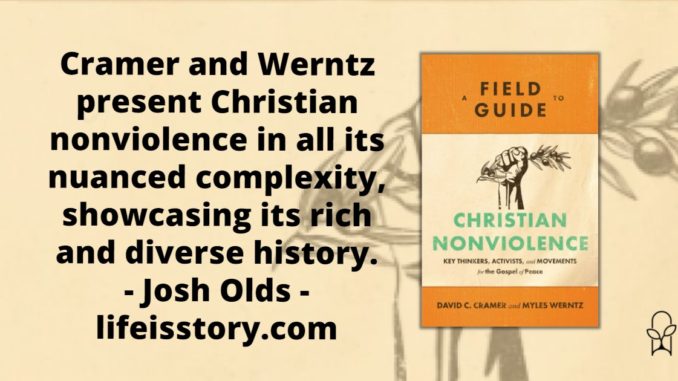
Published by Baker Academic on February 8, 2022
Genres: Academic, Non-Fiction, Christian Life
Buy on Amazon
Goodreads

Christian nonviolence is not a settled position but a vibrant and living tradition. This book offers a concise introduction to diverse approaches to, proponents of, and resources for this tradition. It explores the myriad biblical, theological, and practical dimensions of Christian nonviolence as represented by a variety of twentieth- and twenty-first-century thinkers and movements, including previously underrepresented voices. The authors invite readers to explore this tradition and discover how they might live out the gospel in our modern world.
Right around the time I became a pacifist—thank you to Nonviolence: The Revolutionary Way of Jesus by Preston Sprinkle for that—I began to seek out other, more academic writings on Christian nonviolence and quickly ran across John Howard Yoder. This was also right when Yoder’s long history of sexual abuse and violence was being brought to light. Yoder’s influence on Christian pacifism was undeniable. Now, with a foundational pillar in the movement removed, could Christian nonviolence continue to stand?
A Field Guide to Christian Nonviolence is, in some way, an attempt to move beyond the writings of John Howard Yoder and show that there is a rich and diverse history of pacifism and nonviolence that is completely separate from the problematic influence of Yoder. For decades, Yoder and his writings dominated the discussion of nonviolence, particularly in Anabaptist-specific circles. Cramer and Wertz show readers that we can leave Yoder behind without any need to try to distinguish the man from the message because that message has been exemplified in the work and writings of others.
The book divides Christian nonviolence into eight different streams of thought. The first four tends toward what we might call the a “faithfulness” type of nonviolence, in that its primary focus is how nonviolence in lived out in the context of faith. The latter four tend toward a more practical outlook that seeks effectiveness in society at large. The eight streams of Christian nonviolence are, broadly put:
- Nonviolence as Christian discipleship. Ecclesiocentric nonviolence (if you want to use big words) focuses on the role of the gathered Christian community to practice nonviolence. Specifically, this stream sees the church is bearing witness to and reflecting who God is, and sees God as fundamentally and intrinsically nonviolent.
- Nonviolence as Christian virtue. This stream presents nonviolence as a way of life, wherein violent action of any sort is seen as incompatible with Christian virtue. Cramer and Wentz identify luminaries such as Dorothy Day and Stanley Hauerwas as fitting within this stream.
- Nonviolence of Christian mysticism. Perhaps the most idiosyncratic of the streams, this stream sees violence as a result of a distorted vision of ourselves and of God. The struggle against violence first happens inside one’s self.
- Apocalyptic Nonviolence. Taking the term “apocalypse” in its literal meaning of “unveiling,” this stream is dedicated to emphasizing the conflict between Christ’s way of life and the world’s way of Death.
- Realist nonviolence. Probably the most well-known and practical stream, this version of nonviolence seeks justice, equity, and equality. We might liken it to the social gospel movement.
- Nonviolence as political practice. This is the emphasis of Martin Luther King, Jr. Nonviolence is something that cannot just be practiced by individuals, but must be practiced by nation-states as well. Our structures and institutions must create policy that is antiviolent and seeks to reduced violence toward others.
- Liberationist nonviolence. This stream of thinking comes from the larger thinking of liberation theology and seeks to not just not participate in violence but work actively to prevent and undo violence.
- Christian antiviolence. This final stream gives Werntz and Cramer space to talk about gender, sexuality, and based violence.
As you can see, there’s a lot of space for overlap and the distinctions from one stream to the other are not so well-defined or clear. Yet, in broad scope, this categorization helps differentiate some elements of thought within Christian nonviolence.
The only real criticism I have of A Field Guide to Christian Nonviolence is that its focus, being primarily on presenting the various cases for nonviolence, never spends time on rebutting some fairly common arguments and criticisms or discuss how one stream is different from or similar to others. For example, the chapter on nonviolence on Christian discipleship writes that adherents hold that God is inherently nonviolent. How does that fit with the Flood or Conquest narratives? Granted, it is a field guide and not a critical analysis, but I would like to have seen a section on common arguments against the stream and answers given to them.
The primary value of A Field Guide to Christian Nonviolence is that it accurately portrays nonviolent theory as multi-faceted and even in tension or contradiction at times. Too often, pacifism is portrayed by its opponents as monolithic movement with similar guiding beliefs and goals. Cramer and Wertz present Christian nonviolence from all major perspectives, writing about most major players, and delineating the philosophical and practical differences between them all. And in the end, the do not fall for the fallacy of synthesizing these streams into a “true” Christian nonviolence, but content themselves to live in a complexity that realizes Christian nonviolence is bigger than any one goal or movement.
